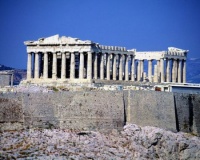Acropolis of Athens (c. 495 – 429 BC)
The Pre-eminent Monument on the European Cultural Heritage[edit]
The Acropolis is the site of four of the greatest masterpieces of classical Greek civilization – the Parthenon, the Propylaea, the Erechtheum, and the Temple of Athena Nike. Built in the 5th century BC, it constitutes an artistic achievement of staggering size and quality; a distillation of what the first Greek democracy could produce, and a testament to human capability and creativity. The Acropolis of Athens is situated on a high rocky outcrop above the city, and has a highly unique symbolic and cultural value, symbolizing democracy and indeed the beginning of Western civilization. The Parthenon, the most well-known of the monuments in the Acropolis, was dedicated to Athena Parthenos, the patron goddess of the city of Athens and goddess of wisdom, and today represents one of the most tangible links to classical Greek civilization and the classical spirit. The monuments were constructed at a time when thought and the arts were flourishing, as an extraordinary group of artists – under the tutelage of the sculptor Pheidias – put into effect the ambitious plans of Athenian statesman Pericles. In 1986, the inaugural Olympic Games were staged in Athens, as Ancient Greece was the birthplace of the concept of the Olympic Games. Thus, the Acropolis should be viewed as the rightful home of the greatest example of cultural diplomacy in the sporting world.
